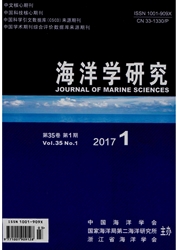

 中文摘要:
中文摘要:
利用SeaWiFS卫星遥感叶绿素质量浓度及TRMM微波遥感海表温度产品,研究了南海海表叶绿素a的季节变化特征及其同海表温度的关系。研究结果表明,南海叶绿素质量浓度具有很强的季节变化:通常低叶绿素质量浓度(〈0.12mg·m-2)出现在弱风、高海表温度(〉28℃)的春、夏季节;高叶绿素质量浓度(〉0.13mg·m-3)出现在有较强风速和较低海表温度(〈27℃)的冬季。线性回归分析显示,南海叶绿素质量浓度同海表温度呈显著负相关关系。尽管在南海南部、南海中部、南海西部及吕宋西北部4个代表子区域的显著性有所差异,但都暗示温度变化所反映的垂向层化调控了营养盐质量浓度和浮游植物量变化。可见,温度可能是影响海洋上层稳定程度及垂向交换强度的重要指标,从而可能调控营养盐及浮游植物的变化。
 英文摘要:
英文摘要:
Based on the SeaWiFS-derived chlorophyll-a (Chl-a) mass concentration and TRMM sea-surface temperature data from September 1997 to February 2007 from the South China Sea (SCS), seasonal variations of Chl-a and its relationship with sea surface temperature (SST) were studied. The results show that the Chl- a mass concentration of the SCS has remarkable seasonal variability. Generally the lowest phytoplankton Chl- a mass concentration(〈0. 12 mg m-3) occurs in spring or summer with low wind speed and high SST (〉28 ℃ ), while the highest Chl-a mass concentration (〉0.16 mg m a ) occurs in winter with the strongest monsoon wind and low SST (〈27 ℃). The linear regression analysis shows that Chl-a mass concentration has obvious negative correlations with SST. Though the correlations level is different for the 4 typical sub- regions of the south, central, and west SCS and the upwelling zone southeast of Vietnam, the consistent negative correlations imply that the Chl-a mass concentration and phytoplankton biomass are controlled by vertical stratification reflected by the temperature variation. The SST is a key factor influencing the upper ocean stability and the strength of vertical exchanges, and thus controlling the variations of nutrients and phytoplankton.
 同期刊论文项目
同期刊论文项目
 同项目期刊论文
同项目期刊论文
 A dipole wind curl pattern induced by Taiwan Island and its effect on upper stratification in the no
A dipole wind curl pattern induced by Taiwan Island and its effect on upper stratification in the no Low-frequency western Pacific Ocean sea level and circulation changes due to the connectivity of the
Low-frequency western Pacific Ocean sea level and circulation changes due to the connectivity of the Correlation between subsurface high-salinitywater in the northern South China Sea and the North Equa
Correlation between subsurface high-salinitywater in the northern South China Sea and the North Equa 期刊信息
期刊信息
